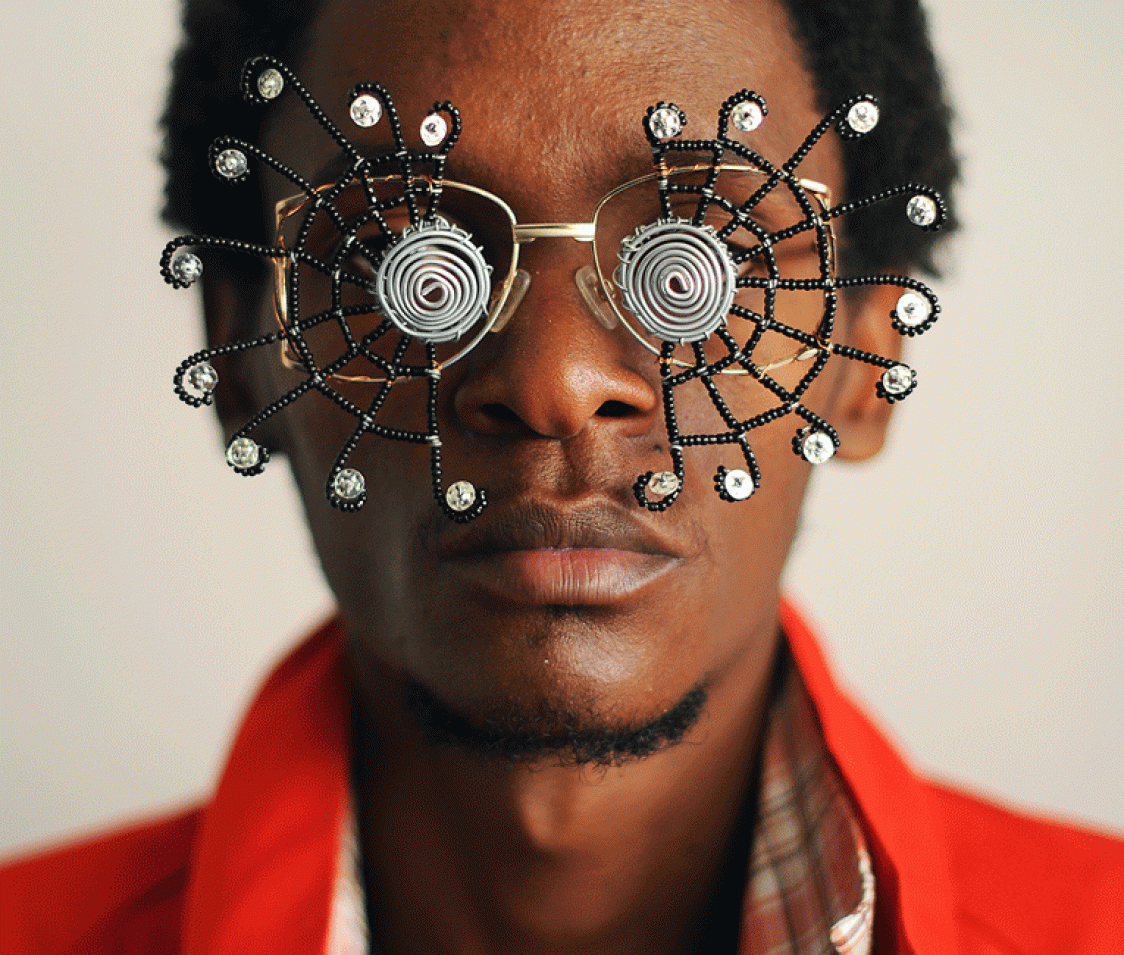MAKING AFRICA – A CONTINENT OF CONTEMPORARY DESIGN
Guggenheim Museum Bilbao
Curators: Amelie Klein, Vitra Design Museum; Petra Joos, Guggenheim Museum Bilbao
Dates: October 30, 2015–February 21, 2016
The Guggenheim Museum Bilbao presents Making Africa – A Continent of Contemporary Design, an exhibition organized by the Guggenheim Museum Bilbao and Vitra Design Museum, in collaboration with the German Federal Culture Foundation and the Art Mentor Foundation Lucerne.
Demonstrating the political, economic, social, cultural, and technological transformation of the continent, the show exhibits work from a diverse range of creative fields: object and furniture design graphic arts, illustration, fashion, architecture, urban planning, craft, film, photography, as well as digital and analogue approaches.
This evolution, especially evident in Africa, is led by a new generation of thinkers and makers, who propose multidisciplinary, innovative solutions for the continent and the world, simultaneously revolutionizing our traditional understanding of design.
The works in the exhibition provide concrete answers to the question of what 21st Century design can and should achieve. These pieces are often created in small quantities by a collective of individuals; they are typically produced de-centrally, in an urban context, and are more oriented to the process than the result. They often emerge from the informal maker culture, in which something existing is reworked or new work is produced with traditional and electronic tools. The works establish connections between the digital revolution and our analogue existence, radically rethink materials, concentrate on society rather than the market, and make bold statements about the future.
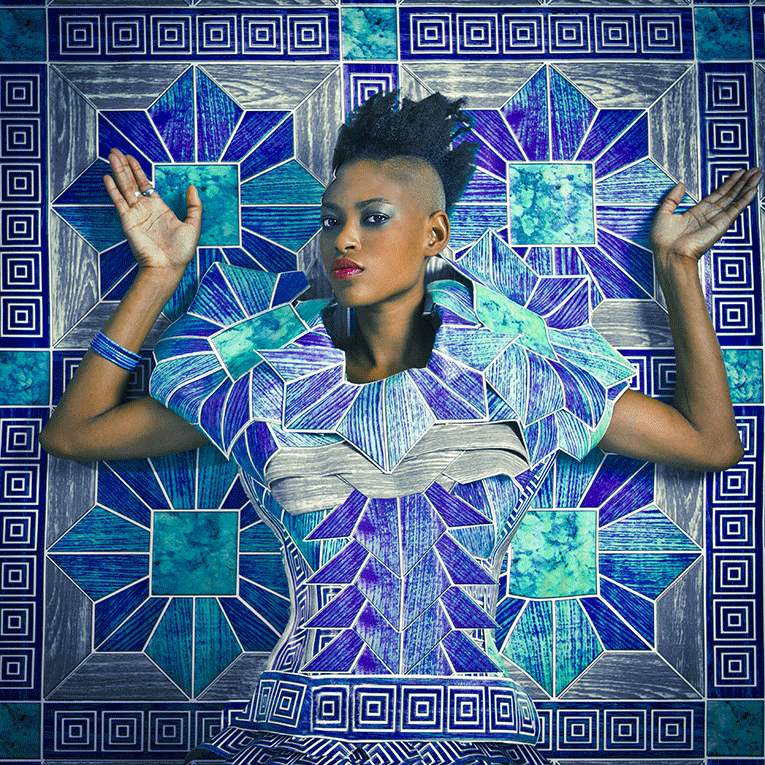
Omar Victor Diop, Mame, 2014
These contemporary creations forge a link to the middle of the twentieth century, when a young generation celebrated its liberation from colonialism by asserting its place in the world and its right to a promising future. The exhibition does not strive to present a complete picture of design in Africa, an impossible task due to the size, complexity, and diversity of a continent with 54 nations, more than 2,000 languages and cultures, and a billion inhabitants. What the exhibition offers instead is a new narrative - one possibility among the many that could appear as we look at Africa—and a clear invitation to consider this continent from an entirely new perspective.
The challenge of Making Africa – A Continent of Contemporary Design is to shed new light on contemporary African design through the work of over 120 artists and designers and to illustrate how design accompanies and drives political and economic change on the continent. The exhibition presents Africa as a hub of experimentation generating new approaches and solutions of worldwide relevance and as a driving force for a new discussion about the potential of design in the twenty-first century. The exhibition focuses on a new generation of African entrepreneurs, thinkers, and designers—'digital natives' who address a global audience and provide a new vantage point on their continent. They often work across several disciplines simultaneously and break with the conventional definitions of design, art, photography, architecture, and film.
When the 'African boom' comes up in the media, the reports tend to focus on the continent's rapid economic growth and the expanding middle class, phenomena that will remain at the root of fundamental changes in the coming decades. However, another development has altered the everyday lives of all Africans and yields a significant influence on the work of artists and designers. At present, there are 650 million mobile phones in Africa, more than in Europe or the United States. Many of these devices have access to the internet and thus create a platform to communicate and exchange information with the world. This technology has generated and enabled a shift in perspective that lies at the center of Making Africa – A Continent of Contemporary Design.
A Tour though the exhibition
The show is divided into four parts. The first part, Prologue, is concerned with the western preconceptions of Africa and poses a series of questions, like, who is talking about the continent and how? The second part, I and We, explores how we communicate about ourselves and with other individuals, groups, or societies. The third part, Space and Object, is dedicated to how the environment influences the individual and his creative output. The fourth and final part, Origin and Future, explores the notion of time: the precolonial and colonial past, the recent past, and the future.
Prologue 208, 205
An especially distinctive feature of the exhibition is its development process. Over a two-year research period, numerous meetings were held in major African cities, such as Lagos, Dakar, Cape Town, Cairo, and Nairobi. In these sessions, 70 designers, artists, researchers, architects, gallery owners, and curators shared their opinions on key questions, like, what is design? What is Africa? What is African design? Their answers generated interesting audio-visual records, -22 of the interviews can be seen in this Prologue- which enabled the exhibition to be undertaken from a new perspective, free from clichés and preconceptions.
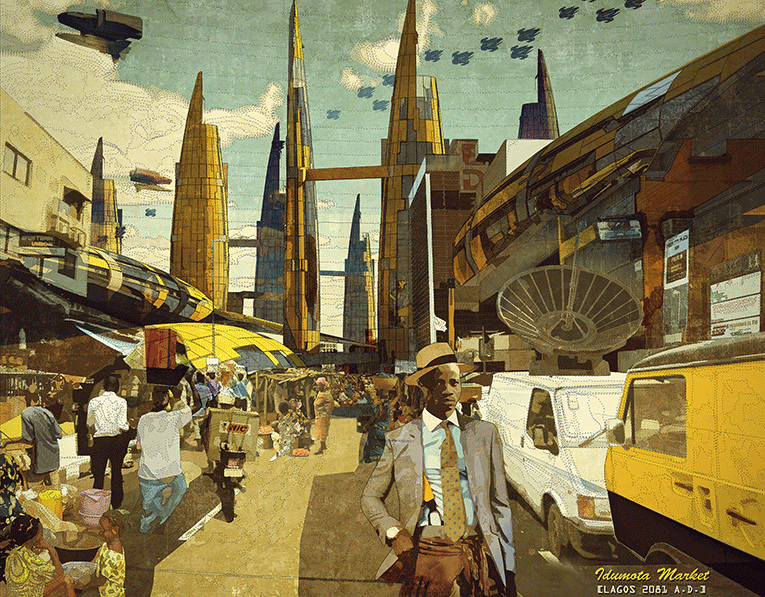
Ikiré Jones, Idumota Market, Lagos 2081 A.D.
The underlying idea in this exhibition is that Africa stands for much more than famine, corruption, or imposing landscapes. African design covers a fascinating spectrum of concerns that goes beyond recycling, traditional craft, or humanitarian design.
The Prologue section offsets the view of Africa defined for centuries by the accounts of European researchers and missionaries, with works that probe stereotypes and representation matters and with interviews featuring design theorists and practitioners from all over Africa and the diaspora. They discuss whether there is such a thing as African design, how we can redefine concepts like recycling and informality, if the continent is reflected in its creative sector, and what design can mean for the future of Africa.
The eyewear sculptures by the Kenyan artist Cyrus Kabiru and Tristes tropiques: illustrations hors texte, a work by Laurence Aëgerter, new in Bilbao, which connects images of people from different eras and latitudes, provide compelling metaphors for the shift in perspective that is urgently needed today.
I and We, 206, 207
In our daily interactions, design provides an effective tool to communicate about ourselves, to demonstrate belonging, and also to set ourselves apart from others. Social networks, blogs, and YouTube are used as a stage for self-expression by a new generation of Africans, who regard themselves quite naturally as part of a global culture. Partying and having fun take on a political dimension, much as they did some fifty years ago when most countries on the continent gained independence and photographers, such as Malick Sidibé or Seydou Keita, captured the sentiments of a new era.
Social and cultural developments in Africa are not simply a matter of copying worldwide trends, as demonstrated by several flourishing subcultures, like Botswana's heavy metal scene or the Sapeurs in the Republic of Congo. Both groups utilize western styling, either through studded leather or dapper suits and panama hats. However, the aesthetic codes are reinterpreted in a new, unique way, creating a distinctly African cultural form. Fashion is also employed as a vehicle for exploring the boundaries between the sexes, from seduction to gender roles, and also supplies a means of expression for sexual minorities.
One example is Wangechi Mutu's The End of Eating Everything , in which a Medusa-like female, played by the North American singer Santigold, hovers over a post-apocalyptic landscape. She comes across a swarm of birds and greedily begins to eat them. Her throbbing, monstrous body gradually becomes visible, covered with lesions. She spouts human limbs, parts of machines, and her pores spew out poisonous smoke. She finally implodes, giving birth to numerous female heads. This monster symbolizes planet Earth and the unending consumption of modern society.
The political dimension inherent to all these works is often complemented by a social aspect. Kunlé Adeyemi's buildings for Chicoco Radio show how civil resistance can be manifested in architecture.And in her series of vases with a Chinese porcelain aesthetic, the ceramic artist Lucinda Mudge addresses the fear of criminality, social inequality, and other issues that affect her native South Africa.
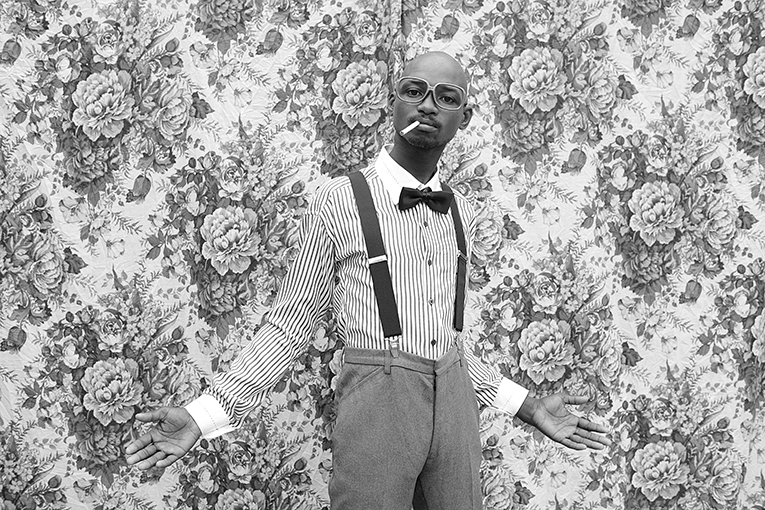
Mário Macilau, Alito, The Guy with Style
The journal Clam, exhibited in Bilbao as a new feature of this section, is an African publication with worldwide circulation, specialized in African fashion, architecture, music, innovation, art, and design, and created, in the words of its founders, to "simply speak about how we really are".
Space and Object 209
By the middle of the twenty-first century, 65 to 70 percent of the world's population will live in cities, and design will have to respond to the ensuing challenges. Today, we can already see the strong influence that the city and its high degree of informality have on creative work in Africa. Tahir Carl Karmali, Bodys Isek Kingelez, Vigilism, Michael MacGarry, Mikhael Subotzky, Meshac Gaba, James Muriuki, and Peterson Kamwathi are artists whose works revolve around the city. Proposals like Justin Plunkett's highly speculative corrugated metal tower offer a provocative approach to the social, economic, political, and cultural realities taking shape in the density of urban centers. Space and Object is devoted to individuals and their living spaces. In addition to the city, this section looks at technologies, materials, and entire systems that shape personal environments.
It examines how manmade spaces confront nature: steel with clay, recycling with traditional craft. M-Pesa is an example of a response to a void and to the lack of infrastructure on the continent, enabling low-income earners to quickly transfer money outside the official banking system that remains inaccessible to them. The mobile money transfer system, introduced by the mobile phone provider Safaricom in 2007, is very simple. It is operated by a network of local M-Pesa agents, who also sell gasoline, food, and newspapers in their shops. The desired amount is deposited in one location and paid out at another upon the presentation of a code sent by SMS. Around 25 percent of Kenya's gross national product flows through the system.
Origin and Future 202
In many respects, culture in Africa is global. YouTube videos by pop stars like Beyoncé or Katy Perry are clicked on just as frequently as anywhere else. At the same time, the culture is deeply anchored in the history of the continent, and a large part of the creative sector now seeks to reflect those roots, especially as a response to globalization. The website of the French-Congolese musician Taali M, for example, should be understood as an invitation to an ancient African kingdom, according to the art director Pierre-Christophe Gam. A key role is played by Africa's long history of colonization and, in particular, a type of textile that erroneously became a symbol of (West) African tradition: Dutch Wax, also called Ankara. In the mid-nineteenth century, several Dutch and English companies commenced industrial production of Indonesian batik fabrics, among which Vlisco soon became the market leader. How the fabrics made their way to Africa is subject to debate, but the colorfully patterned textiles became so popular on that continent that they never reached the Dutch market for which they were originally intended. Today, many designers and artists use those patterns in their creations.
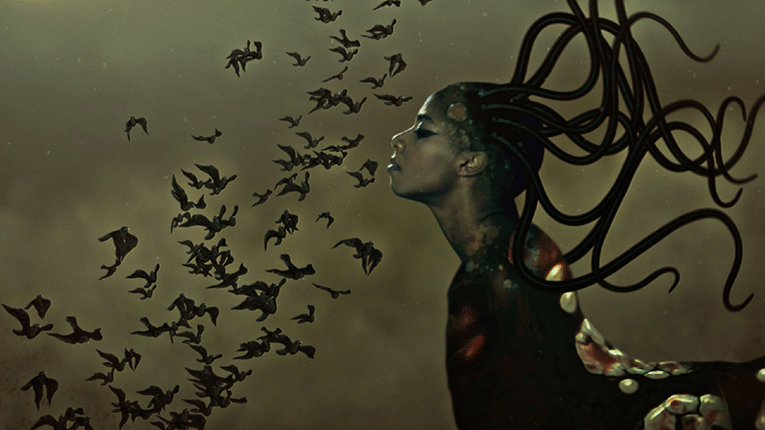
Wangechi Mutu, The End of eating Everything [film still], 2013
At the same time, an increasing number of critical voices have questioned the embrace of this colonial commodity. In recent history, Nelson Mandela has served as a figure of identification across the entire continent, and artists and designers alike have found a common denominator in their visions of the future: slightly dystopian in the underlying mood, but always linked to a hopeful conclusion. This can be seen in a scarf by the US-Nigerian fashion label Ikiré Jones, which features a depiction of Paris in 2081: a vision of the future in which visitors from the new Africa garner more admiration than the Eiffel Tower. "As immigrants, they were derided and looked down upon," explains a text on the label's website. "That was years ago. Now they advance through the crowds of onlookers as lenses point in their direction and tourists ask each other who they were." An audacious vision, which could come true someday.
Cinema 203
This gallery showcases the most avant-garde films of the African continent, such as Afronauts (2014) by Frances Bodomo, born in Ghana and a resident of New York, and Pumzi (2009) by Wanuri Kajiu, born in Kenya and a resident of Nairobi.
Exhibition Design and Historical References
Making Africa – A Continent of Contemporary Design aims to offer a new perspective on Africa and African design. The colored glass panels of the exhibition provide different views, inviting the visitor to change his standpoint and his perspective. What appears colored (seen through a glass panel) turns out to be different once we move closer or change our point of view. In a subtle way, the panels also address the cognitive filters through which the Western societies from the North perceive Africa. They reference the idea of a more ―layered‖ or ―multifaceted‖ view of the continent.
Although the exhibition focuses on a new generation of creative professionals on the continent, these often reference their grandparent‘s generation, which gained independence. The design of the exhibition reflects these two narratives, reproducing historical material (photographs and reprints of Drum magazine) directly on the exhibition architecture. Thus, history quite literally becomes a backdrop for the current work.
Catalogue
The exhibition is accompanied by an illustrated catalogue, which showcases, throughout more than 300 pages, works by these artists and others: essays by Amelie Klein, Koyo Kouoh, Avisash Rajagopal and Vera Sacchetti, Azu Nwagbogu and Odessa Legemah; interviews with Okwui Enwezor, Mugendi M'Rithaa and Edgar Pieterse; and extracts from the think tanks in Lagos, Dakar, Cape Town, Cairo, and Nairobi. It reveals the development of the show, as well as the volume that accompanies it.
Didaktika: Unlimited!
In connection with the exhibition Making Africa — A Continent of Contemporary Design , the Didaktika project presents Unlimited!, a broad program of educational activities. A series of workshops led by a selection of exhibiting artists will provide a more hands-on experience, such as the design and furniture workshop by Yinka Ilori or the fashion and textile workshop inspired by modern African design.
Lectures and roundtable discussions will explore the central topic of design in connection with other transversal themes addressed in the show. Before its opening, exhibition curators Amelie Klein and Petra Joos will discuss the project‘s inception and development, as well as current designers‘ practice in Africa.
Further activities related to the exhibition will be held. On the occasion of the MEM Festival the museum will host Estrecho Exchange, a unique performance by artists Omar Saadoune and Ana Matey born of dialogue. The project is based on their history of digital correspondence and their subsequent face-to-face meeting and collaboration in Morocco.
The Shared Reflections tours led by museum staff will unveil the highlights and the behind-thescenes work of the exhibition by revealing its curatorial vision and its key concepts.
Gallery guides
Visitors can consult the gallery guides for more information on the works shown through a free service of the Museum, available from 11 a.m. to 2 p.m.
Address:
Guggenheim Museum Bilbao
Abandoibarra Etorb.,
2, 48009 Bilbo, Bizkaia, Spain
+34 944 35 90 80
www.guggenheim-bilbao.es
www.guggenheim-bilbao.es
Image Credits:
1. Cyrus Kabiru, Caribbean Sun;
From the series C-Stunners , 2012; C-print, 150 x 100 cm. © Carl de Sauza/AFP/Getty Images
2. Omar Victor Diop, Mame, 2014
From the series The Studio of Vanities; Pigment inkjet printing on Harman by Hahnemühle paper
93 x 93 cm. Courtesy Magnin-A Gallery, Paris. © Omar Victor Diop, 2014
3. Ikiré Jones, Idumota Market, Lagos 2081 A.D.
From the series Our Africa 2081 A.D. , 2014
Digital print, 35 x 45 cm. © Olalekan Jeyfous & Walé Oyéjidé
4. Mário Macilau, Alito, The Guy with Style,
From the series Moments of Transition, 2013;
Digital print, 80 x 120 cm. Courtesy Ed Cross Fine Art Ltd, London
© Mário Macilau
5. Wangechi Mutu, The End of eating Everything [film still], 2013
Animated video in color, with sound, 8 min., 10 sec. Edition of 6 + 2 A.P.
Courtesy the artist, Gladstone Gallery and Victoria Miro Gallery.
Commissioned by the Nasher Museum of Art at
Duke University, Durham, NC

